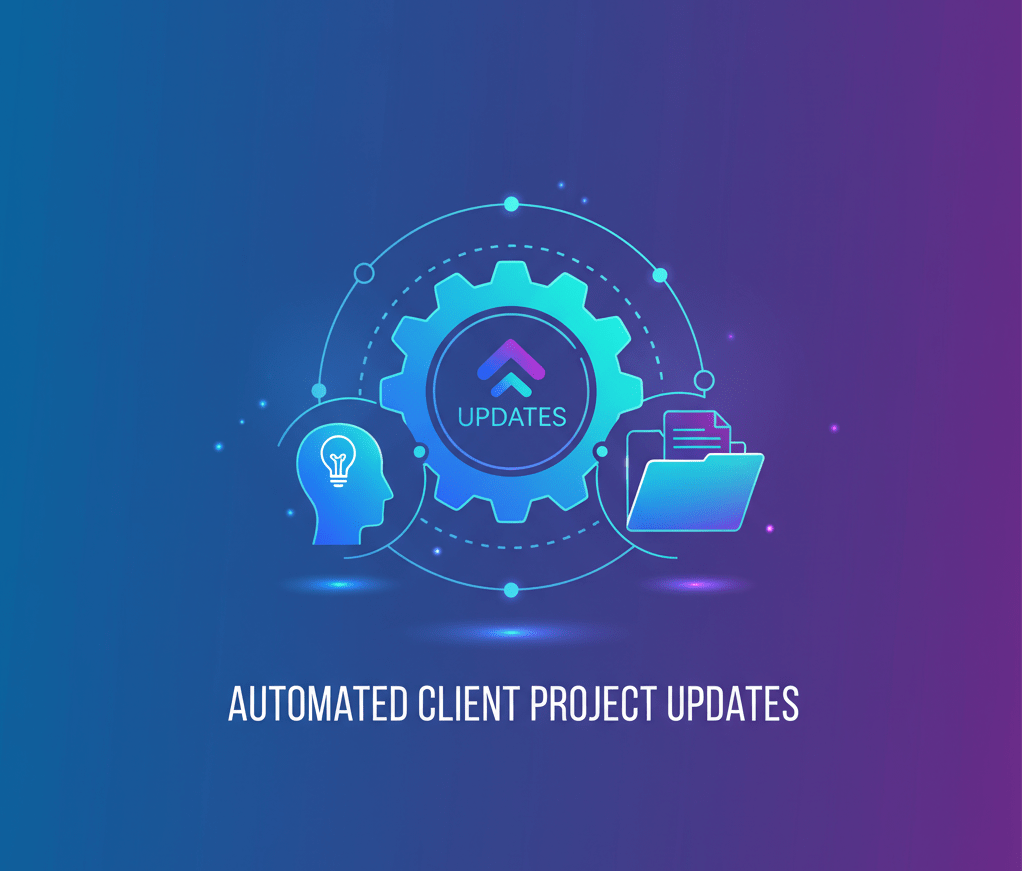“Enable Automated Client Project Updates 24/7 with an AI agent that pulls live data from your PM tools to answer status questions and eliminate constant “checking in.””
“Just checking in.”
Two simple words. Yet, for anyone running an agency, consultancy, or service-based business, they can trigger a groan. A sigh. Maybe even a full-blown existential crisis about time management. Those frequent emails and calls from clients, eager for an update, are a constant drain. They interrupt deep work, pull project managers away from critical tasks, and fragment your team’s focus. It’s a never-ending cycle of answering the same questions, often with information that’s already accessible but not immediately apparent to the client.
This isn’t about clients being demanding. It’s about a fundamental need for transparency and reassurance. They’ve invested in your expertise. They want to know their project is on track, progressing as expected. When those updates aren’t readily available, anxiety creeps in. This leads to more “just checking in” messages, and the cycle intensifies.
But what if there was a better way? A way to keep clients informed, happy, and confident, without sacrificing your team’s precious time and focus? What if you could provide automated client project updates on demand, whenever your clients wanted them?
Welcome to the future of client communication: an AI project status agent.

The Silent Killer of Productivity: Constant Client Check-ins
Let’s be honest. The current system for client updates is broken for many service businesses.
Consider a typical scenario:
Sarah, a project manager at a busy digital marketing agency, is deep in strategy for a new client launch. She’s in the zone, crafting compelling ad copy, optimizing landing pages, and coordinating with her design team. Then, an email notification pops up: “Any updates on our website redesign?” It’s from Mark, a key client.
Sarah sighs. She knows Mark isn’t being difficult. He’s just anxious. His boss asked him for a status update. Sarah needs to respond. She opens the project management software, sifts through recent comments, checks task lists, and then drafts an email. This takes her at least 15-20 minutes, pulling her out of her creative flow. By the time she gets back to the ad copy, her train of thought is gone. The momentum is lost.
Multiply this by five, ten, or even twenty clients, each with their own “just checking in” cadence, and you have a significant chunk of your team’s day consumed by administrative communication. This isn’t value-added work. It’s reactive, repetitive, and utterly inefficient.
This constant interruption isn’t just annoying; it has real costs:
- Reduced Productivity: Every time a team member switches contexts, it takes time to refocus. Studies suggest it can take over 20 minutes to return to a complex task after an interruption.
- Increased Stress & Burnout: The pressure to constantly respond to client inquiries, often while juggling demanding project tasks, creates a high-stress environment.
- Delayed Project Timelines: If project managers are spending hours each week on status updates, they have less time for actual project execution. This can push back deadlines.
- Fragmented Focus: Teams struggle to achieve “deep work” when they’re constantly on alert for client questions.
- Higher Operational Costs: Time spent on manual updates is billable time that isn’t being spent on delivering core services.
We need a way to improve client transparency without increasing the burden on our teams. We need a solution that empowers clients with information while freeing our experts to do what they do best: create, innovate, and deliver outstanding results.
The Promise of Automated Client Project Updates
Imagine a world where your clients never have to “just check in” again. They simply ask a question and get an immediate, accurate answer. This isn’t science fiction. It’s entirely achievable with an AI project status agent.
This isn’t just about sending automated emails. This is about creating an interactive, on-demand experience for your clients. Think of it as a dedicated digital assistant for each project, always available, always informed.
Here’s how it works at a high level:
- AI Training: You train an AI agent on your project’s data. This includes project timelines, key milestones, recent updates, completed tasks, and upcoming deliverables.
- Client Interaction: Clients can interact with this AI agent at any time through a simple chat interface. They can ask questions in natural language.
- Instant Answers: The AI agent processes their query, accesses the relevant project information, and provides an instant, accurate update.
This system provides a true win-win. Clients get the transparency and reassurance they crave, instantly. Your team gets uninterrupted time to focus on their work.
Building Client Trust Through Transparency
One of the most significant benefits of automated client project updates is the profound impact on client trust. When clients feel informed and in control, their confidence in your agency grows.
Think about it:
- Always On: Clients no longer need to wait for business hours or for a project manager to become available. They can get an update at 2 AM if they wish. This constant availability is a powerful trust builder.
- Consistent Information: The AI agent draws from a single source of truth – your project data. This ensures consistency and accuracy in every update, eliminating potential discrepancies from different team members.
- Empowerment: Clients feel empowered when they can retrieve information themselves. They aren’t waiting for permission or a human gatekeeper.
- Proactive Information: While the interaction is on-demand, the system fosters a sense of proactive communication. Clients know they can always access the latest information, rather than feeling like they have to chase it.
This level of transparency goes beyond merely reporting progress. It shows clients that you value their peace of mind. It demonstrates a commitment to open communication, cementing your reputation as a reliable and client-focused partner.
Key Components of an AI Project Status Agent
To build an effective AI project status agent, you need a few core ingredients. The good news is that these pieces are becoming increasingly accessible.
1. Your Project Data: This is the fuel for your AI. The more comprehensive and organized your project data is, the brighter your AI agent will be. This includes:
- Project Timelines: Start and end dates, phase durations.
- Key Milestones: Crucial checkpoints, deliverables, and their target dates.
- Task Lists & Progress: What’s done, what’s in progress, who’s working on what.
- Recent Updates/Comments: Daily or weekly summaries, internal notes, decisions made.
- Document Links: Relevant files, briefs, designs, or reports.
- Budgets (Optional): If applicable, and you want to share this level of detail.
This data typically resides in your existing project management software.
2. Natural Language Processing (NLP) Capabilities: This is what allows the AI to understand client questions posed in plain English (or any other language). It translates “What’s the status of the new homepage design?” into a query it can answer by looking at your data.
3. Integration with Project Management Tools: For true automation, your AI agent needs to connect directly with where your project data lives. This could be tools like:
- Basecamp
- Asana
- Trello
- Jira
- Monday.com
- ClickUp
- Smartsheet
- And many others.
This integration is critical. It means the AI always has the most up-to-date information, eliminating the need for manual input from your team.
4. A User-Friendly Interface for Clients: How will clients interact with the AI? This could be:
- A dedicated chat widget on your website or client portal.
- An integration with popular messaging apps (e.g., Slack, Microsoft Teams).
- A custom client portal alternative that hosts the AI agent.
The more straightforward the interface, the more likely clients are to use it.
Implementing Your AI Project Status Agent: A Step-by-Step Guide
The idea of implementing AI might sound complex, but with the right tools, it’s becoming incredibly straightforward. Here’s a general roadmap for getting your automated client project updates up and running:
Step 1: Audit Your Current Project Data
Before you can train an AI, you need to know what data you have and where it lives.
- Are your project timelines clear and updated regularly?
- Are milestones clearly defined and tracked?
- Do your tasks have clear statuses (e.g., “To Do,” “In Progress,” “Completed”)?
- Are notes and updates consistent?
The cleaner and more organized your project management system is, the easier it will be to train your AI and achieve accurate results. This is an excellent opportunity to refine your internal processes if they’re in disarray.
Step 2: Define the Scope of Information for Clients
Not all internal project data is suitable for client consumption. Decide what level of detail you want your AI agent to provide.
- Do you want it to share specific task assignments?
- Should it offer budget updates?
- Will it explain complex technical challenges, or simply report on their impact on the timeline?
Begin with the most frequently asked client questions. These typically revolve around overall progress, upcoming milestones, and potential blockers. You can expand the scope later.
Step 3: Choose Your AI Agent Builder (No-Code is Key!)
This is where the magic happens. Look for a no-code AI Agent Builder. These platforms allow you to create and train an AI without needing any programming skills.
Key features to look for:
- Ease of Use: A drag-and-drop interface or simple configuration options.
- Integration Capabilities: Connectors to your existing project management software.
- Training Flexibility: The ability to feed it various data sources (documents, URLs, text).
- Customization: Personalize the agent’s name, tone, and responses to match your brand.
- Deployment Options: How easily can you embed it into a client portal or share a link?
Step 4: Train Your AI Agent
This is the core process. You’ll feed your AI agent all the relevant project data.
- Connect to PM Tools: Utilize the integrations to pull live data from Basecamp, Asana, and other platforms.
- Upload Documents: Provide project briefs, SOWs, initial timelines, and client expectations.
- Input FAQs: Manually input common questions clients ask and the desired answers. This acts as a foundation.
- Define Responses: Guide the AI on how to answer specific types of questions. For example, if a client asks, “When will X be done?”, teach them to look for the due date of task X.
The more data and guidance you give the AI, the more intelligent and helpful it will become. Think of it as teaching a very eager intern everything they need to know about a project.
Step 5: Test and Refine
Before launching to clients, rigorously test your AI agent.
- Ask common client questions. Does it provide accurate answers?
- Test edge cases. What happens if a client asks something unusual?
- Check for clarity and tone. Does it sound professional and helpful?
- Get internal feedback. Have team members who are familiar with the project interact with it.
Use this feedback to refine the training. Add more data, clarify responses, and adjust the understanding. This iterative process is crucial for success.
Step 6: Deploy and Introduce to Clients
Once you’re confident in your AI agent, it’s time to deploy it.
- Communicate Clearly: Introduce the AI agent to your clients. Explain its purpose – to provide instant, on-demand updates. Position it as a benefit to them, offering faster access to information.
- Provide Access: Share the link to the client portal or chat widget where they can interact with the agent.
- Set Expectations: Explain what kinds of questions the AI can answer and when they should still reach out to their human contact for more nuanced discussions.
Monitor its performance initially. Be ready to jump in if a client has a question the AI can’t answer. This initial oversight will help you identify further training opportunities.
Beyond Status: The Future Potential of Client-Facing AI
While starting with automated client project updates is a decisive first step, the capabilities of client-facing AI agents extend far beyond simple status reports.
Consider these future possibilities:
- Resource Center: The AI could link clients directly to relevant documents, mockups, or reports based on their queries.
- FAQ Management: Beyond project-specific questions, it could answer general questions about your services, billing, or policies.
- Meeting Summaries: Automatically generate concise summaries of client meetings, highlighting key decisions and next steps.
- Proactive Alerts: The AI could send proactive alerts to clients about significant project milestones or potential delays, further reducing the need for manual check-ins.
- Feedback Collection: It could guide clients through a structured feedback process at different stages of a project.
The journey starts with automated project updates. The destination offers a richer, more efficient, and more satisfying overall client experience.
Scalewise.ai: Your Simplest Path to Automated Client Updates
Implementing an AI project status agent might sound like a big undertaking. But it doesn’t have to be. This is where tools like Scalewise.ai truly shine.
Scalewise.ai offers the simplest way to get this system up and running. It’s a free, no-code AI Agent Builder. This means:
- No Technical Expertise Needed: You don’t need to hire developers or learn complex AI concepts. If you can manage a project, you can build an AI agent with Scalewise.ai.
- Quick Setup: Create a dedicated project status bot in minutes, not weeks or months.
- Seamless Integration: Connect it to your existing project management tools (Basecamp, Asana, Trello, etc.) to pull live data. This is crucial for maintaining the accuracy and up-to-date nature of your AI agent.
- Intuitive Training: Feed it your project timelines, milestones, and updates through an easy-to-use interface.
- Customizable: Tailor the AI agent’s responses and personality to align with your brand voice.
- Fosters Transparency: Provide your clients with the ability to receive instant updates whenever needed, reducing their anxiety and building greater trust.
- Frees Your Team: Stop the endless cycle of “just checking in” emails and calls. Your project managers and team members can focus on delivering exceptional work, rather than spending time on repetitive communication tasks.
Scalewise.ai makes the power of AI accessible to every project manager. It removes barriers, allowing you to implement a solution that quickly transforms client communication, improves client transparency, and significantly reduces administrative overhead.
Imagine logging in tomorrow morning to find zero “just checking in” emails. Instead, you see happy clients who have already gotten their answers from your dedicated AI project status agent. That’s the reality Scalewise.ai helps you create. It’s about working smarter, not harder.
Conclusion: Reclaiming Your Time, Building Stronger Client Relationships
The constant barrage of “just checking in” requests is more than an annoyance. It’s a systemic problem impacting productivity, team morale, and ultimately, your ability to deliver excellent results. Traditional methods of client communication, while well-intentioned, often fall short in today’s fast-paced environment. They create bottlenecks and disrupt workflow.
Automated client project updates, powered by an AI project status agent, represent a fundamental shift. They move client communication from a reactive, human-dependent process to a proactive, on-demand, and highly efficient system. This change isn’t about replacing human interaction; it’s about optimizing it. It frees your team to engage in more meaningful, strategic conversations with clients, rather than merely reciting status updates.
By providing clients with instant, accurate information whenever they need it, you significantly improve client transparency and build stronger, more trusting relationships. Clients feel valued, informed, and confident in your work. Your team, meanwhile, enjoys uninterrupted focus, resulting in higher-quality output and reduced stress.
Stop letting administrative tasks drain your agency’s energy and resources. Embrace the future of client communication. Explore how an AI project status agent can transform your operations. With a free, no-code solution like Scalewise.ai, implementing this powerful tool is simpler than ever. It’s time to empower your clients, free your team, and redefine what “staying updated” truly means.
Start building better client relationships and reclaim your team’s valuable time today.
FAQs: Automated Client Project Updates with AI
Q1: What exactly is an AI project status agent?
A: An AI project status agent is a specialized artificial intelligence program. It’s trained on your specific project data, like timelines, milestones, and recent updates. Clients can interact with it through a chat interface. They ask questions about the project’s progress. The AI then provides immediate, accurate answers, drawing on the information it was trained on.
Q2: How does this reduce client check-in meetings and emails?
A: Clients often send “just checking in” messages because they lack immediate access to information. An AI agent provides instant, 24/7 access to project updates. Clients receive their answers whenever they need them. This reduces their need to wait for a human response. Thus, fewer emails and fewer impromptu calls interrupt your team’s work.
Q3: Is this really “no-code”? Do I need to be a developer to set it up?
A: Yes, many modern AI agent builders, like Scalewise.ai, are truly no-code. This means you don’t write any programming code. Instead, you use intuitive interfaces. You connect to your project management tools. You then “train” the AI by feeding it your project data. If you can manage a project, you can set up one of these agents.
Q4: What kind of information can the AI agent provide to clients?
A: The AI agent can provide any information you train it on. This commonly includes:
- Overall project progress (e.g., “60% complete”).
- Status of key milestones (e.g., “Website design approved by XX date”).
- Upcoming deliverables and their estimated completion dates.
- Recent updates or achievements.
- Answers to frequently asked questions about the project or your services. You control the level of detail it shares.
Q5: How does the AI agent stay updated with the latest project information?
A: The best AI agent builders integrate directly with your existing project management software. These could include tools such as Asana, Basecamp, Trello, Jira, or others. Once connected, the AI agent can pull live, real-time data from these systems. This ensures the information it provides to clients is always current.
Q6: Can the AI agent answer specific questions about tasks or individual team members?
A: Yes, if you train it with that level of detail, it can. For example, if your project management system tracks who is assigned to each task, the AI can report on this information. You determine the granularity of information the AI has access to. You also set the boundaries for what it shares with clients.
Q7: Will this replace my project managers or human client contact?
A: No, it won’t replace human interaction. It streamlines the routine, repetitive aspects of communication. This frees up your project managers. They can then focus on higher-value activities. These include strategic discussions, problem-solving, and building deeper relationships with clients. The AI handles the factual updates. Your team handles the nuanced discussions.
Q8: What if a client asks a question the AI can’t answer?
A: A well-designed AI agent should recognize when it can’t provide a satisfactory answer. In such cases, it should prompt the client to connect with their human project manager in a graceful manner. This ensures that clients always receive the information they need, whether from the AI or your team. This also helps you identify areas for further AI training.
Q9: Is my client’s data safe when using an AI agent builder?
A: Reputable AI agent builders prioritize data security and privacy. They use encryption and adhere to industry best practices. Before choosing a platform, review its security policies and data handling practices. Ensure they meet your compliance requirements.
Q10: Can I customize the AI agent’s persona or tone of voice?
A: Absolutely. Most advanced AI agent builders allow for significant customization. You can name your agent. You can define its tone (e.g., professional, friendly, formal). You can also craft specific responses to match your brand’s voice. This makes the client experience feel more consistent and branded.





